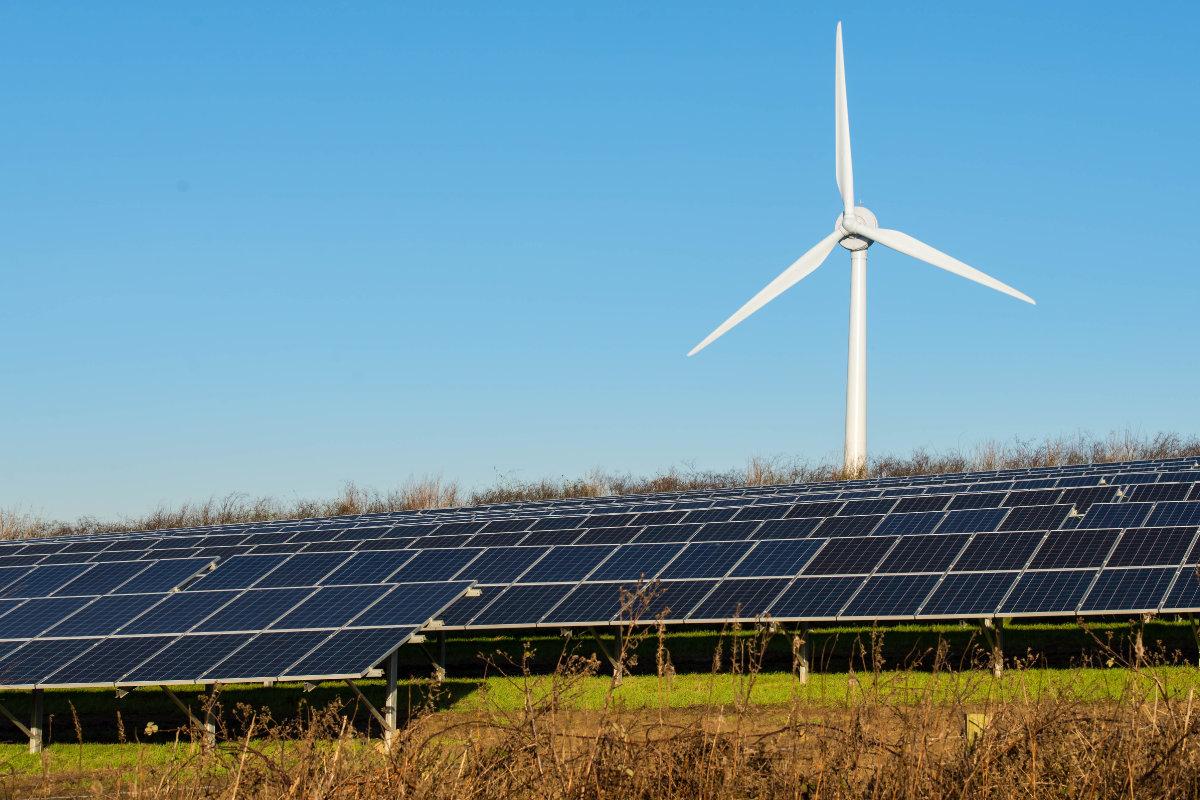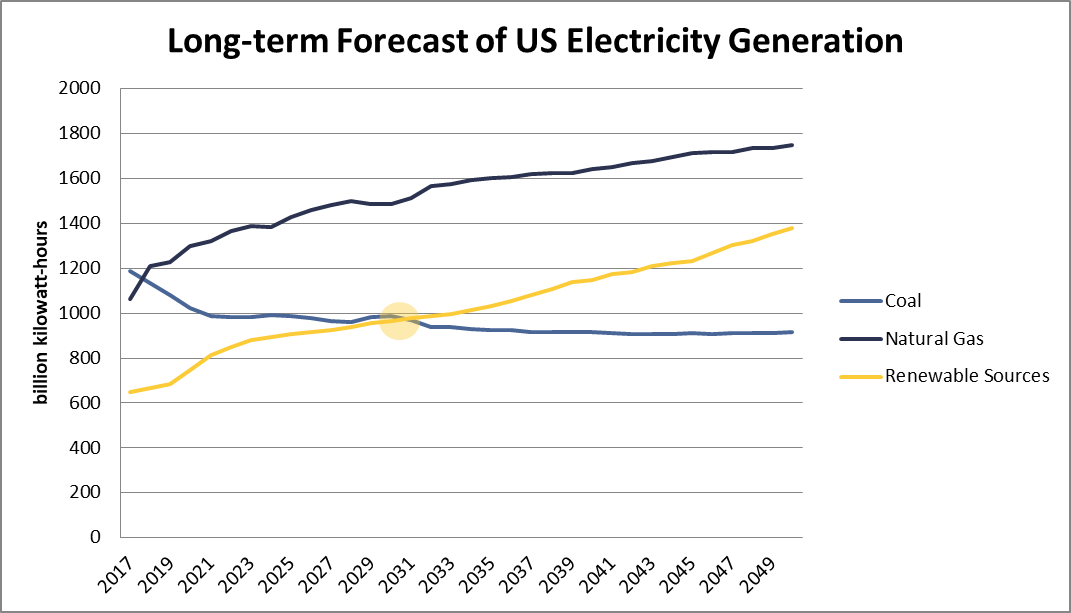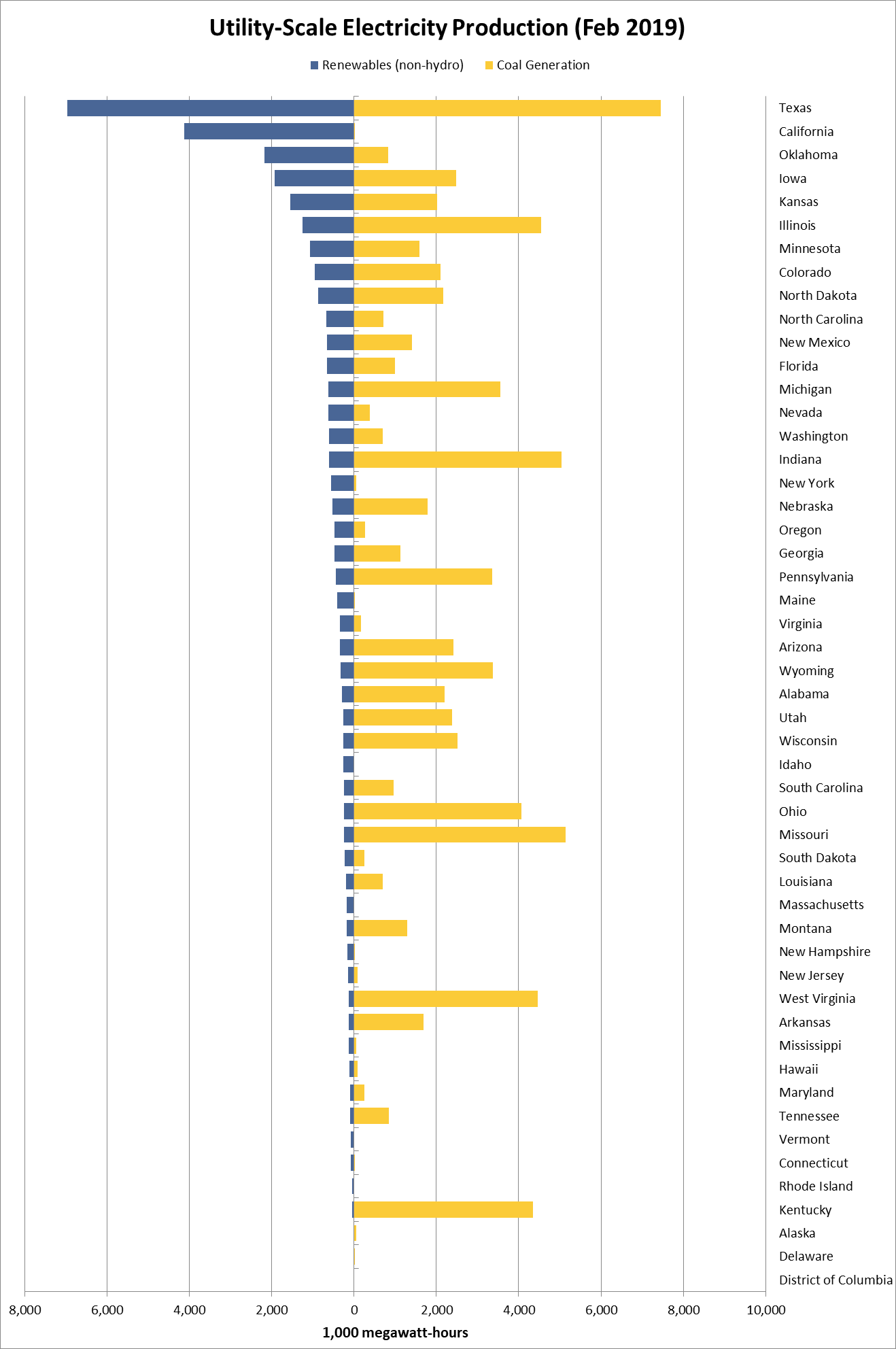The U.S. renewable energy sector reached a significant milestone in April when government projections showed renewable energy sources beating coal generation nationwide for the first time in history, a trend that continued into May.
While the flip is partially brought on by the seasonality of hydro and coal generation, it shows that we’re in the beginning stages of a major change in the electricity industry, as the U.S. Energy Information Administration (EIA) expects utilities to continue replacing coal plants with solar and natural gas plants for the next couple decades.
Renewable energy beat coal in April and May
According to estimates from the EIA, nationwide electricity generation from renewable sources –driven mainly by solar, wind, and hydropower – is set to exceed coal generation twice this year, first in April then in May, as noted in the above graph.
In April, the EIA estimates the U.S. generated 2,390 MWh per day of renewable energy and only 1,884 MWh of electricity from coal – about 22% less than renewables. The gap narrows in May, with renewable energy just barely squeaking by with 2,278 MWh – a scant 8 MWh more than May’s coal generation.
You’ll also notice in the graph that renewable generation is expected to top coal again from March to May next year, peaking in April when renewables should outperform coal by 40%.
Just two decades ago, when coal was the top dog among electricity generation, these numbers were probably unthinkable to utilities or the coal industry. In the entire month of May 2001, for example, the US generated 29,000 GWh of electricity from renewable sources, equal to just 19% of coal’s total energy production.
This month’s momentous change is largely brought on by three main causes: 1) the utility industry continuing a long-term move away from coal-fired generation, in favor of cheaper natural gas, solar, and wind, 2) a steady increase in solar and wind generation, and, as IEEFA pointed out in a recent article on the topic, 3) seasonal changes in electricity generation, since hydropower bumps up from March to May each year during spring runoff and coal generation decreases as utilities prepare the plants for the summer season.
While the flip was certainly brief, it’s certainly a sign of the times, as coal becomes increasingly unprofitable and more utilities continue to turn to solar and energy storage. Financial services firm, Lazard, publishes annual estimates of the lifecycle costs of both renewable and conventional fuel sources. In their 2018 study, the firm found that on-shore wind and solar energy are the cheapest forms of electricity, at $29/MWh and $36/MWh respectively, with natural gas close behind at $41/MWh. Coal, on the other hand, comes in at $60/MWh, with nuclear, residential solar, and gas peaking plants coming in the highest.
Renewables set to permanently top coal by 2031
While the inversions above were brief, lasting only a couple months, the EIA expects renewable generation to permanently overtake coal by 2031, as noted in the long-term forecast above. Renewable energy should grow from just 666 million MWh in 2018, to 980 million MWh by 2031, before continuing on to 1,400 MWh/year by 2050. These increases are brought on mainly by steady growth in solar energy specifically, driven by tax credits in the near term and continued falling prices in the long term.
Back here in 2019, we’re quite literally watching the bottom fall out of the coal industry, as coal use has been in rapid decline since the mid-2000s. As utilities continue retiring aging or surplus plants, experts expect coal use to continue its sharp decline until the early 2020s, at which point it will begin to decrease more gradually.
While renewables have certainly played a hand in coal’s ongoing destruction, the true power here is natural gas, as coal simply can’t beat natural gas generation’s persistently low price and cleaner emissions. Natural gas permanently overtook coal as the dominant fuel source in 2018 and the EIA expects natural gas to continue reigning for the foreseeable future, growing in parallel to renewables and at a very similar rate.
Renewable Generation Varies by State
At this time, renewable energy generation varies state to state, with solar and wind concentrated in areas with high electricity rates, suitable locations (either strong wind or sun), and policies that encourage renewable adoption.
The chart below compares each state’s electricity production from coal and renewables in February 2019. You’ll see that renewables actually outperformed coal in 16 states across the US, from California and Oregon in the west, to New York, New Jersey, and Connecticut in the east. Even a couple states in the south and mid-west, namely Oklahoma and Mississippi, produced more electricity from renewables than coal.
February is typically a time when coal plants aren’t in peak season, as utilities wane down production and prepare for the summer peak. As such, summer generation figures will likely be very different in some states. This comparison also leaves out natural gas generation, which is the single biggest replacement for coal-fired electricity. However, the chart does show that renewable energy, even without hydroelectricity, is already a large part of our existing electricity industry.
As solar installation costs continue to fall, the EIA expects solar alone to make up 15% of all electricity production by 2050, with the fastest growth in the eastern half of the US, as utilities construct large-scale solar installations.
Solar and renewable energy advocates will rejoice at this recent history-making energy news, while coal proponents will likely wave it off as a blip on the radar. However, with utilities continuing to rapidly retire coal plants in favor of cheaper solar and natural gas, we’re well into the beginning stages of a sea change in the energy industry.
Cover photo source: Flickr








